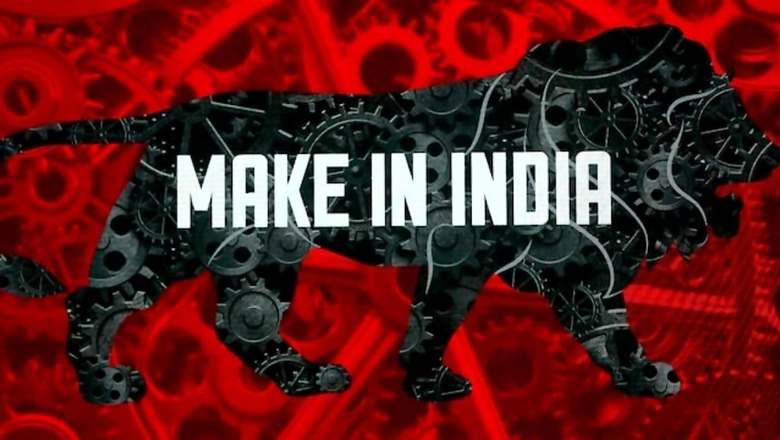
views
The Make in India initiative, under Prime Minister Narendra Modi, is based on four pillars, identified to boost entrepreneurship.
- New Processes: Make in India recognises the importance of ease of doing business. The aim is to de-license and deregulate.
- New Infrastructure: The Modi government is developing industrial corridors and smart cities to provide infrastructure based on state-of-the-art technology, with modern high-speed communication and integrated logistics. The intellectual property rights registration system has been upgraded.
- New Sectors: Make in India has identified 25 sectors spanning manufacturing, infrastructure and services.
- New Mindset: The Make in India initiative is fostering a significant shift in how the government interacts with industry. The Modi administration’s approach is that of a facilitator, rather than a regulator.
The Make in India programme has been built on layers of collaborative effort aimed at increasing the contribution of the manufacturing sector to 25 per cent of GDP. A key indicator of progress is the unprecedented opening up of sectors such as railways, defence, insurance, and medical devices to much higher levels of foreign direct investment.
From amendments in labour laws to the online filing of returns, and from rationalising the regulatory environment to extending the validity of industrial licences, a host of changes have been introduced to make ‘Make in India’ a reality, thanks to Prime Minister Modi’s dynamic vision.
To position India as a manufacturing hub, the Modi government extended the Production Linked Incentive (PLI) scheme to 14 sectors in 2021, the largest of which is the smartphone PLI scheme with an outlay of Rs 40,995 crore. Under the scheme, the government estimates a total incremental production of Rs 10.05 lakh crore, exports exceeding Rs 6.5 lakh crore, and direct and indirect employment of at least 8 lakh, possibly more, by 2026.
In a glowing endorsement of PM Modi’s Make in India, last year India produced more than 330 million mobile handsets, making it the second-largest mobile manufacturer in the world. Xiaomi has acknowledged that 99 per cent of its phones are Made in India, with 65 per cent of components locally sourced. Moreover, 95 per cent of Xiaomi’s 35,000-strong workforce in India are women.
Global tech giant Apple is keen to make India its manufacturing hub, with its contractor Foxconn assembling iPhones, and Pegatron and Wistron assembling other variants in India. Apple’s suppliers, Foxconn, Wistron, and Pegatron, together employ over 60,000 workers in India. This is part of Apple’s larger plan to shift over 45-50 per cent of its production volumes to India by 2026.
Speaking of iPhones, the very first Apple product available for sale in India was the Macintosh computer, way back in 1998. But guess what? It wasn’t until April 18, 2023, that Apple opened its first store in Mumbai. Essentially, it took 25 years for Apple to open a store in India. The good news, however, is that iPhones worth Rs 3.6 lakh crore are slated to be produced in India over the next five years, with over 80 per cent earmarked for export. Overall, more than 97 per cent of smartphones sold in India are now produced locally—a remarkable achievement.
Turning to the states, Haryana under the BJP over the last 10 years has been a huge success story for Modi’s “Make in India” initiative. As recently as February 2024, the prime minister laid the foundation stone for various projects during his visit to Rewari. These projects, with an estimated value of over Rs 9,750 crore, encompass significant advancements in the health, rail, and tourism sectors of the state.
One of the key projects to be inaugurated is the Gurugram Metro Rail Project, with an investment of approximately Rs 5,450 crore. Spanning 28.5 kilometres, this project will link Millennium City Centre to Udyog Vihar Phase 5, integrating seamlessly with the existing Rapid Metro Rail network in Gurugram. Additionally, the foundation stone for AIIMS Rewari has already been laid, symbolising the government’s commitment to strengthening public health infrastructure across the nation. With an estimated cost of Rs 1,650 crore, AIIMS Rewari will include state-of-the-art facilities, including a hospital complex with 720 beds, a medical college, a nursing college, an AYUSH block, residential accommodation, and various other amenities.
These initiatives, as part of “Make in India”, underscore PM Modi’s resolve to bolster Haryana’s infrastructure, providing residents with access to world-class healthcare and transportation facilities, and fostering overall socio-economic development in the state.
“For making India self-reliant, five things are necessary: intent, innovation, investment, inclusion, and infrastructure. We must first create a robust local supply chain to help India play a key role in the global supply chain. We have been working continuously to create a favourable ecosystem for investment and business. Lakhs of MSMEs in India are the engines of the country’s overall growth. Today, the rest of the world holds India in high regard and has trust in our nation. The world is looking for a trustworthy partner, and India has the potential and capability to ensure that we are that partner.” These profound and sincere words from PM Modi clearly highlight the modern, globally competitive, and India-centric approach of Modinomics, without being inward-looking when it comes to ‘Make in India’.
Apart from companies like Apple or Samsung, the big beneficiaries of the Modi government’s PLI scheme are homegrown players such as Lava, Karbonn, Micromax, and Intex. ‘Make in India’, based on access to markets, capital, and technology, is not just a slogan but a work ethic that is rapidly transforming India’s industrial landscape. This is driven, among other factors, by Modi’s unrelenting global outreach.
With the Tata Group acquiring Wistron’s India operations, it will mark the first time a local company moves into the assembly of iPhones. An Indian company producing iPhones will serve as a significant boost to PM Modi’s persistent efforts to challenge China’s status as the factory of the world. In fact, China’s dominance in this regard is already starting to recede. ‘Made in China’ is increasingly becoming passé, while ‘Make in India’, under the visionary leadership of PM Modi, is now taking over.
One of the most significant sectors receiving attention under “Make in India” is semiconductors. Gujarat, a hub of innovation, is now home to major players like Micron Technology in Sanand, with Tata Electronics entering a joint venture with Taiwan’s Powerchip Semiconductor Manufacturing Corp. in Dholera. According to the India Electronics and Semiconductor Association (IESA), semiconductor demand in India is expected to surge from $40 billion to over $100 billion by 2030. The SEMICON India 2024 event saw participation from over 250 companies across 24 countries, eager to explore India’s rapidly evolving semiconductor ecosystem.
India’s burgeoning semiconductor space has attracted both global and domestic giants, including Israel’s Tower Semiconductor, US-based Lam Research, Tokyo Electron Ltd, Kaynes Semicon, Mindgrove, the Adani Group, Larsen & Toubro Ltd., Renesas, AMD, and NXP Semiconductors.
Before concluding, let us discuss Snapdeal, founded by Kunal Bahl in 2010, which achieved a valuation of $6.5 billion within just six years of its inception. However, by 2017, it was on the brink of collapse due to mounting debt, reckless expansion, and significant cash burn resulting from an overleveraged business model. Hence, it is commendable that Snapdeal has risen from the ashes.
Amidst the pandemic, it added over six million users. Today, Snapdeal’s founders have made angel investments in more than 200 startups through their company, Titan Capital. Recent investments include 91 Trucks, the consumer brand Boba Bhai, and the software service Simplismart, among others. Titan Capital’s portfolio has also featured popular companies such as Ola Cabs, RazorPay, and Giva Jewellery.
Snapdeal’s humble beginnings, meteoric rise, fall, and subsequent turnaround signify several lessons. The most important one is never to lose focus and to never go overboard.
While comparisons are often odious, Prime Minister Narendra Modi’s Make in India, despite being written off by a weakened Opposition, never lost focus, which is precisely why it has become a force to be reckoned with. Make in India, with its focus on land, labour, liquidity, and laws, is not merely about import substitution or exclusion—it is about being self-sustaining and self-generating, free from the constraints of an outdated Nehruvian model steeped in isolationism.
The evidence of Modi’s rapidly evolving Make in India initiative is far too significant to be ignored. Take Samsung, for instance, which has the world’s largest mobile manufacturing facility in India, or Amazon, which boasts the world’s largest fulfilment centre in India. Additionally, the gigantic GIFT City in Gujarat, covering 7 million square feet, is even larger than the Pentagon complex, which spans 6.5 million square feet.
Suffice to say, Modi’s Make in India is about size, scale, and sunrise sectors, but above all, it embodies an inclusive work ethic that values innovation and ease of doing business, leaving no room for complacency. It is precisely this work ethic that has made India the world’s third-largest start-up ecosystem, serving as a ringing endorsement of Modinomics.
Sanju Verma is an Economist, National Spokesperson for BJP and Bestselling Author of “The Modi Gambit”. Views expressed in the above piece are personal and solely that of the author. They do not necessarily reflect News18’s views.



















Comments
0 comment